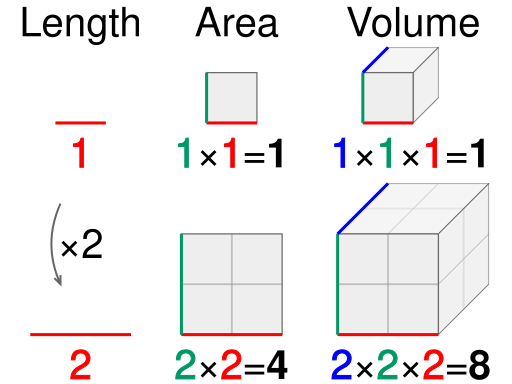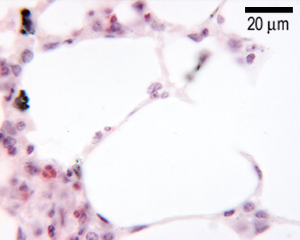OCR Specification focus:
‘As organisms increase in size and activity, SA:V falls and metabolic demands rise, so specialised surfaces for ventilation and gas exchange become essential in multicellular organisms.’
The Need for Specialised Exchange Surfaces
As organisms grow larger and more active, their surface area to volume ratio (SA:V) decreases, while metabolic demands increase, creating the need for specialised exchange surfaces to efficiently obtain oxygen, remove carbon dioxide, and manage nutrient and waste transport.
Surface Area to Volume Ratio (SA:V)
Surface Area to Volume Ratio (SA:V): The relationship between an organism’s total external surface area and its internal volume, influencing the rate of exchange with the environment.
Smaller organisms, such as unicellular organisms, possess a large SA:V, allowing gases and nutrients to diffuse directly across their body surface quickly enough to meet their metabolic needs. However, as organisms become larger and multicellular, their volume increases faster than surface area, reducing the relative area available for exchange.
In a cube model, when each side doubles, surface area increases by a factor of four, but volume increases by a factor of eight.

This clean diagram illustrates how length (L), surface area (∝ L²) and volume (∝ L³) scale as objects enlarge. As volume grows faster than surface area, the SA:V decreases, limiting simple diffusion. This scaling principle explains why larger, active multicellular organisms require specialised exchange surfaces. Source.
This geometric relationship demonstrates why diffusion alone becomes insufficient in larger organisms.
Limitations of Diffusion in Large Organisms
Diffusion is a passive process driven by concentration gradients. In small organisms, diffusion distances are short, and the entire cell can obtain sufficient oxygen and nutrients. In contrast, in multicellular organisms, most cells are located far from the external environment, creating long diffusion distances and slower rates of molecular movement.
Diffusion: The passive net movement of particles from an area of higher concentration to an area of lower concentration, down a concentration gradient.
This limitation means simple diffusion cannot supply oxygen or remove waste quickly enough to sustain the metabolic activity of larger organisms, especially those that are highly active and require continuous ATP production through aerobic respiration.
Increasing Metabolic Demands
Metabolic rate—the rate at which energy is used by an organism—rises with both size and activity level. Animals that move actively, maintain internal body temperatures, or exhibit complex behaviours demand greater oxygen and nutrient intake.
For example:
Endothermic mammals and birds maintain constant body temperatures, requiring large amounts of energy for thermoregulation.
Insects and fish with active movement patterns also demand efficient oxygen supply mechanisms.
Consequently, these organisms evolve specialised structures and transport systems to meet their increased energy needs.
Evolutionary Solutions: Specialised Exchange Surfaces
Specialised exchange surfaces have evolved to maximise the efficiency of gas and nutrient transfer. These structures provide adaptations that overcome the limitations of size and diffusion distance.
Key features typically include:
Large surface area: Increases the area available for diffusion.
Thin barrier: Reduces diffusion distance for faster transfer.
Good blood supply or ventilation: Maintains concentration gradients of gases or solutes.
These principles apply across taxa: from alveoli in mammalian lungs to gill lamellae in fish and tracheoles in insects.
Relationship Between SA:V and Metabolic Activity
EQUATION
—-----------------------------------------------------------------
Surface Area to Volume Ratio (SA:V) = Surface Area / Volume
Surface Area = Total area through which exchange occurs (m²)
Volume = Internal space of the organism (m³)
—-----------------------------------------------------------------
As SA:V decreases, less surface is available per unit volume for diffusion. Therefore, active transport and bulk movement systems become essential to maintain efficient exchange.
Organisms with low SA:V rely on:
Ventilation systems (e.g. lungs, tracheae) to move gases efficiently.
Circulatory systems (e.g. blood, haemolymph) to transport substances rapidly.
Examples of Specialisation
Unicellular Organisms
Exchange occurs directly across the cell membrane.
High SA:V and simple structure allow efficient gas and nutrient exchange.
Oxygen diffuses directly into the cytoplasm for cellular respiration.
Multicellular Organisms
Have cell membranes not directly exposed to the external environment.
Require internal transport systems and specialised exchange organs such as:
Lungs in mammals – provide vast alveolar surface for gas exchange.

A labelled schematic of alveoli showing the capillary network and ultra-thin respiratory membrane that minimises diffusion distance. This illustrates how structure maintains steep O₂/CO₂ gradients and meets high metabolic demand. The diagram includes cell types (Type I and Type II pneumocytes) and surfactant, which is extra detail beyond the syllabus but clarifies why alveoli remain open for efficient exchange. Source.
Gills in fish – use countercurrent flow to maintain diffusion gradients.
Tracheal systems in insects – deliver air directly to tissues.
Maintaining Concentration Gradients
To ensure diffusion remains effective, organisms maintain steep concentration gradients across exchange surfaces. This is achieved by:
Continuous ventilation: replacing external medium to sustain gas differences.
Efficient circulation: transporting substances away from the exchange surface rapidly.
These processes prevent equilibrium, ensuring that oxygen concentration remains higher on one side and carbon dioxide concentration remains higher on the other.
Adaptations for Efficient Gas Exchange
Flattened body shapes (e.g. flatworms) increase surface area relative to volume.
Folding of body surfaces (e.g. alveoli, intestinal villi) enhances available area.
Specialised internal structures ensure protection from desiccation and environmental damage while maintaining access to gases.
Each adaptation demonstrates how evolution compensates for a decreasing SA:V in larger or more metabolically active organisms.
Importance for Survival
Without specialised exchange surfaces, multicellular organisms would not meet their metabolic energy requirements. Inefficient gas exchange would limit aerobic respiration, reducing energy availability for growth, movement, reproduction, and maintaining internal homeostasis. Therefore, the development of these surfaces was essential for the evolution of complex life forms with high energy demands and diverse ecological adaptations.
FAQ
Body shape affects how efficiently an organism can exchange substances with its environment. Flattened or elongated shapes, like those of flatworms, increase the surface area relative to volume, allowing diffusion across the body surface.
Spherical or compact shapes, such as in larger mammals, have a lower SA:V ratio and longer diffusion distances. These animals rely on specialised internal exchange surfaces, like lungs or gills, to maintain efficient gas and nutrient exchange despite their compact body forms.
Diffusion alone is too slow to meet the metabolic demands of large multicellular organisms.
Internal cells are far from the body surface, increasing diffusion distance.
The reduced SA:V ratio limits available area for gas movement.
High oxygen demand and carbon dioxide removal cannot be met passively.
Therefore, such organisms require ventilation systems to move gases and transport systems to deliver them efficiently throughout the body.
Metabolic rate increases with both temperature and activity. In warm-blooded (endothermic) animals, internal temperature is maintained through energy-intensive processes that depend on a steady oxygen supply.
In colder environments, some animals lower their metabolic rate, reducing oxygen demand. However, species with consistently high metabolism, such as mammals and birds, require large, efficient exchange surfaces regardless of external temperature.
While a large surface area increases diffusion, it can also cause water and heat loss.
Organisms balance exchange efficiency with protection and stability by:
Housing exchange surfaces internally (e.g. alveoli in lungs).
Using protective layers like mucus or surfactant.
Employing regulatory mechanisms such as closing spiracles in insects.
Too much exposed surface area would lead to desiccation or thermal imbalance, especially in terrestrial environments.
The evolution of closed circulatory systems and ventilatory mechanisms allowed exchange surfaces to become more efficient.
Blood or haemolymph continuously removes oxygen and delivers carbon dioxide, maintaining concentration gradients.
Ventilation systems move fresh air or water across exchange surfaces, such as alveoli or gills.
Together, these systems enabled multicellular organisms to sustain high metabolic rates and inhabit diverse environments.
Practice Questions
Question 1 (2 marks)
Explain why large multicellular organisms require specialised exchange surfaces.
Mark scheme:
1 mark for stating that as organisms increase in size, their surface area to volume ratio (SA:V) decreases.
1 mark for explaining that this makes diffusion alone insufficient to meet the metabolic demands of internal cells, so specialised exchange surfaces are needed for efficient gas or nutrient exchange.
Question 2 (5 marks)
Describe how the features of an efficient gas exchange surface enable effective diffusion of gases. Use examples from mammals or other organisms to support your answer.
Mark scheme:
1 mark for identifying large surface area (e.g. alveoli or gill lamellae) to maximise diffusion.
1 mark for describing thin diffusion distance (e.g. single layer of epithelial cells).
1 mark for explaining that a steep concentration gradient is maintained by ventilation or good blood supply.
1 mark for linking features to faster diffusion rate and efficient gas exchange.
1 mark for an appropriate example (e.g. alveoli in lungs, gills in fish, tracheoles in insects) clearly connected to the feature described.

